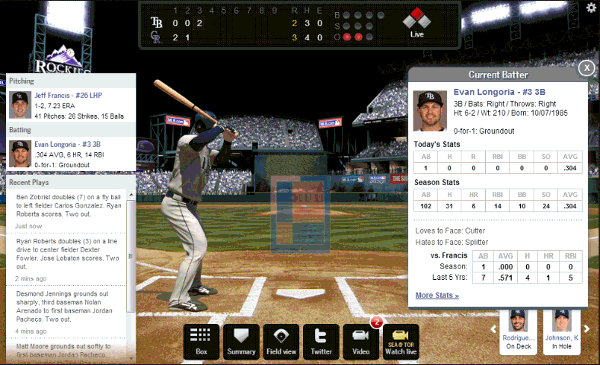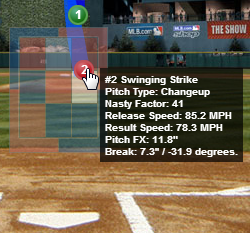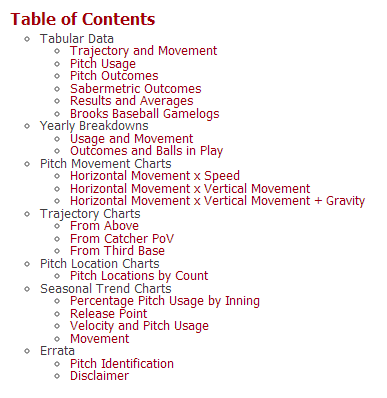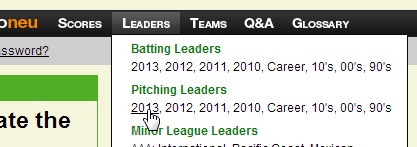If you’re looking for another weapon to add to your fantasy arsenal, understanding and using PITCH f/x data is a great place to start. This article will give you an overview of what PITCH f/x is, what information it provides, and how and where you can obtain PITCH f/x data on the web.
What Is Pitch F/X?
PITCH f/x is a system, developed by Sportvision, installed in all Major League Baseball stadiums to track the movement and velocity of pitches. Even if you’ve never heard of PITCH f/x or analyzed PITCH f/x data, you’ve probably seen it in action via MLB.com’s Gameday system. The pitch animations within Gameday attempt to model the actual velocity, break, and angle of pitches.

While watching the Gameday animation, if you hover over the location of a pitch, you are presented with the pitch result, pitch type, speed, and movement.

What Does Pitch f/x Tell Me?
It’s interesting to look at the data of individual pitches, but because pitch-after-pitch-after-pitch is recorded and logged, we have accumulated a massive amount of pitch data that can be analyzed. With pitch type, pitch speed, pitch movement, and pitcher release point being available, we can answer questions like:
- Has pitcher A altered his approach (pitch type frequency)?
- Has pitcher B added a new pitch?
- Has pitcher C added velocity from the prior year?
- Has pitcher D lost velocity on his fastball?
- Has pitcher E improved the movement on his pitches?
- Has pitcher F changed his release point?
- What percent of the time does pitcher G throw his curve ball for a strike?
- What pitch type for pitcher H generates the most swinging strikes?
What Does This Have To Do With Fantasy Baseball?
There are some very obvious applications. For one, higher fastball velocity is an indicator of higher strike out rates. Decreasing velocity might indicate an injured or aging player losing effectiveness.
Other PITCH f/x information is more difficult to tie directly to fantasy performance, but knowing the information might help explain changes in a player’s performance. Take the case of Edward Mujica, who became a different pitcher after being traded to St. Louis in 2012. Turns out he developed a new pitch that he now throws over 60% of the time. Adding a new pitch and then throwing it with a high frequency would help explain an increase in effectiveness.
Fantasy players are always trying to determine what is real and what performance increases will continue. PITCH f/x data can help unearth the “real” changes in pitcher performance and separate them from a flukey “hot streak”.
Where Do I Find Pitch f/x Data?
There are a number of resources for PITCH f/x data, but my two favorite sources are BrooksBaseball.net and Fangraphs. BrooksBaseball.net offers a ton of information if you’re looking to take a deep dive into an individual player, whereas Fangraphs offers the easiest access to downloadable PITCH f/x data.
Brooks Baseball
BrooksBaseball.net offers PITCH f/x analysis of individual games, of umpires, and of the strike zone, but the pitcher “Player Cards” are what I find most useful for fantasy baseball analysis.
To access a player card, simply type the player’s name into the search box on the main site. Then click the search button.

You’ll be presented with a lengthy table of contents showing just how much information is available on the site.

We’ll dive deeper into certain segments in a future post. But in the meantime, look around. The information is awesome.
Fangraphs
As mentioned above, Fangraphs offers the best sortable and downloadable PITCH f/x information I’ve been able to find. To access this information, go to the “Leaders” menu at Fangraphs and select the desired year under “Pitching Leaders”.

Middle of the way down on the ensuing page, you’ll see categories for all the pitching statistics available at Fangraphs. Choose “PITCH f/x”, the rightmost option.

After making that selection, you have further options to choose from: Pitch Type, Velocity, Movement, and others.

More To Come
Play around with the information at BrooksBaseball and Fangraphs. Leave a comment below or let me know on Twitter if you have any questions.
In an upcoming post, we’ll dive deeper into the data and do some analysis.
Special Thanks
A big thank you is in order to BrooksBaseball.net and Fangraphs.com for offering such great information online and making it available to smart baseball fans.
If You Haven’t Already Done So
Please subscribe to the Smart Fantasy Baseball blog with your e-mail on the top right of this page. I won’t sell your e-mail address and you can unsubscribe at any time. Promise.
Until next time, make smart choices.






